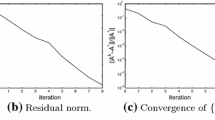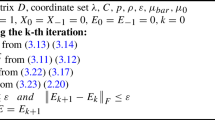Abstract
Robust principal component analysis (PCA) is widely used in many applications, such as image processing, data mining and bioinformatics. The existing methods for solving the robust PCA are mostly based on nuclear norm minimization. Those methods simultaneously minimize all the singular values, and thus the rank cannot be well approximated in practice. We extend the idea of truncated nuclear norm regularization (TNNR) to the robust PCA and consider truncated nuclear norm minimization (TNNM) instead of nuclear norm minimization (NNM). This method only minimizes the smallest N − r singular values to preserve the low-rank components, where N is the number of singular values and r is the matrix rank. Moreover, we propose an effective way to determine r via the shrinkage operator. Then we develop an effective iterative algorithm based on the alternating direction method to solve this optimization problem. Experimental results demonstrate the efficiency and accuracy of the TNNM method. Moreover, this method is much more robust in terms of the rank of the reconstructed matrix and the sparsity of the error.
Similar content being viewed by others
References
CANDÈS E J, LI X D, MA Y, et al. Robust principal component analysis? [J]. Journal of the ACM, 2011, 58(3): 11.
PENG Y G, GANESH A, WRIGHT J, et al. RASL: Robust alignment by sparse and low-rank decomposition for linearly correlated images [J]. IEEE Transactions on Pattern Analysis and Machine Intelligence, 2012, 34(11): 2233–2246.
LIU Y Y, JIAO L C, SHANG F H. A fast trifactorization method for low-rank matrix recovery and completion [J]. Pattern Recognition, 2013, 46(1): 163–173.
WRIGHT J, MA Y, GANESH A, et al. Robust principal component analysis: Exact recovery of corrupted low-rank matrices via convex optimization [C]//Proceedings of the 23rd Neural Information Processing Systems. Vancouver, BC, Canada: ACM, 2009: 2080–2088.
CAI J F, CANDÈS E J, SHEN Z W. A singular value thresholding algorithm for matrix completion [J]. SIAM Journal on Optimization, 2010, 20(4): 1956–1982.
LIN Z C, LIU R S, SU Z X. Linearized alternating direction method with adaptive penalty for low rank representation [C]//Proceedings of the 25th Neural Information Processing Systems. Granada, Spain: [s.n.], 2011: 612–620.
ZHANG D B, HU Y, YE J P, et al. Matrix completion by truncated nuclear norm regularization [C]//Proceedings of the 25th IEEE Conference on Computer Vision and Pattern Recognition. Providence, Rhode Island, USA: IEEE, 2012: 2192–2199.
HU Y, ZHANG D B, YE J P, et al. Fast and accurate matrix completion via truncated nuclear norm regularization [J]. IEEE Transactions on Pattern Analysis and Machine Intelligence, 2013, 35(9): 2117–2130.
GU S H, ZHANG L, ZUO W M, et al. Weighted nuclear norm minimization with application to image denoising [C]//Proceedings of the 27th IEEE Conference on Computer Vision and Pattern Recognition. [s.l.]: IEEE, 2014: 2862–2869.
DONOHO D L. Denoising by soft-thresholding [J]. IEEE Transactions on Information Theory, 1995, 41(3): 613–627.
YANG J F, ZHANG Y. Alternating direction algorithms for l1-problems in compressive sensing [J]. SIAM Journal on Scientific Computing, 2011, 33(1): 250–278.
YUAN X M, YANG J F. Sparse and low-rank matrix decomposition via alternating direction methods [J]. Pacific Journal of Optimization, 2013, 9(1): 167–180.
BABACAN S D, LUESSI M, MOLINA R, et al. Sparse Bayesian methods for low-rank matrix estimation [J]. IEEE Transactions on Signal Processing, 2012, 60(8): 3964–3977.
LI L Y, HUANG W M, GU I Y H, et al. Statistical modeling of complex backgrounds for foreground object detection [J]. IEEE Transactions on Image Processing, 2004, 13(11): 1459–1472.
GEORGHIADES A S, BELHUMEUR P N, KRIEGMAN D J. From few to many: Illumination cone models for face recognition under variable lighting and pose [J]. IEEE Transactions on Pattern Analysis and Machine Intelligence, 2001, 23(6): 643–660.
Author information
Authors and Affiliations
Corresponding author
Additional information
Foundation item: the Doctoral Program of Higher Education of China (No. 20120032110034)
Rights and permissions
About this article
Cite this article
Zhang, Y., Guo, J., Zhao, J. et al. Robust principal component analysis via truncated nuclear norm minimization. J. Shanghai Jiaotong Univ. (Sci.) 21, 576–583 (2016). https://doi.org/10.1007/s12204-016-1765-5
Received:
Published:
Issue Date:
DOI: https://doi.org/10.1007/s12204-016-1765-5
Keywords
- truncated nuclear norm minimization (TNNM)
- robust principal component analysis (PCA)
- low-rank
- alternating direction method




